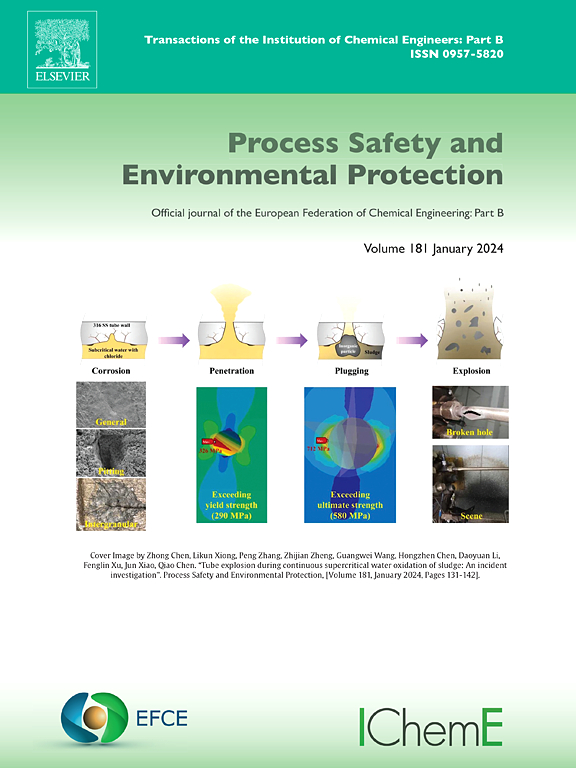LNG泄漏检测激光扫描路径博弈论DBN-CFD-GA优化
IF 6.9
2区 环境科学与生态学
Q1 ENGINEERING, CHEMICAL
引用次数: 0
摘要
提出了一种改进LNG站气体泄漏监测的综合优化方法。传统的扫描路径规划通常依赖于基于经验的扫描点放置,缺乏理论支持,难以适应复杂的站点结构和动态风险变化。该过程从创建3D模型开始,该模型捕获设备及其环境的空间细节,为后续风险评估提供基础。动态贝叶斯网络(DBN)集成了历史数据、实时监控信息和专家见解,以评估设备状态并识别高风险区域。然后,计算流体动力学(CFD)模拟这些区域内的气体扩散,生成详细的气体云分布,从中提取关键扫描点。最后,利用非合作博弈论框架结合遗传算法对激光平台的扫描轨迹进行优化,并识别出高风险区域。该方法的扫描路径长度缩短了37.8% %,检测精度提高了22. %,并且显著降低了能耗和检测时间。这些改进为泄漏监测提供了一种更高效、更具成本效益的解决方案,在扫描效率、安全性和运营成本方面优于实际液化天然气站的传统方法。本文章由计算机程序翻译,如有差异,请以英文原文为准。
Game-theoretic DBN–CFD–GA optimization of laser scan paths for LNG leak detection
This study presents a comprehensive optimization approach to improve gas leakage monitoring in LNG stations. Conventional scanning path planning typically relies on experience-based placement of scan points, lacking theoretical support and struggling to adapt to complex station structures and dynamic risk changes. The process begins with the creation of a 3D model, which captures the spatial details of the equipment and its environment, providing the foundation for subsequent risk assessment. Dynamic Bayesian Networks (DBN) integrate historical data, real-time monitoring information, and expert insights to assess equipment status and identify high-risk zones. Computational Fluid Dynamics (CFD) simulations then model gas dispersion within these zones, generating detailed gas cloud distributions from which critical scanning points are extracted. Finally, a non-cooperative game-theoretic framework combined with Genetic Algorithms (GA) optimizes the laser platform’s scanning trajectory based on the extracted scanning points and identified high-risk areas. The proposed method demonstrates a 37.8 % reduction in scanning path length, a 22 % improvement in detection accuracy, and significant reductions in energy consumption and detection time. These improvements offer a more efficient and cost-effective solution for leakage monitoring, outperforming traditional methods in real-world LNG stations in terms of scanning efficiency, safety, and operational costs.
求助全文
通过发布文献求助,成功后即可免费获取论文全文。
去求助
来源期刊

Process Safety and Environmental Protection
环境科学-工程:化工
CiteScore
11.40
自引率
15.40%
发文量
929
审稿时长
8.0 months
期刊介绍:
The Process Safety and Environmental Protection (PSEP) journal is a leading international publication that focuses on the publication of high-quality, original research papers in the field of engineering, specifically those related to the safety of industrial processes and environmental protection. The journal encourages submissions that present new developments in safety and environmental aspects, particularly those that show how research findings can be applied in process engineering design and practice.
PSEP is particularly interested in research that brings fresh perspectives to established engineering principles, identifies unsolved problems, or suggests directions for future research. The journal also values contributions that push the boundaries of traditional engineering and welcomes multidisciplinary papers.
PSEP's articles are abstracted and indexed by a range of databases and services, which helps to ensure that the journal's research is accessible and recognized in the academic and professional communities. These databases include ANTE, Chemical Abstracts, Chemical Hazards in Industry, Current Contents, Elsevier Engineering Information database, Pascal Francis, Web of Science, Scopus, Engineering Information Database EnCompass LIT (Elsevier), and INSPEC. This wide coverage facilitates the dissemination of the journal's content to a global audience interested in process safety and environmental engineering.
 求助内容:
求助内容: 应助结果提醒方式:
应助结果提醒方式:


